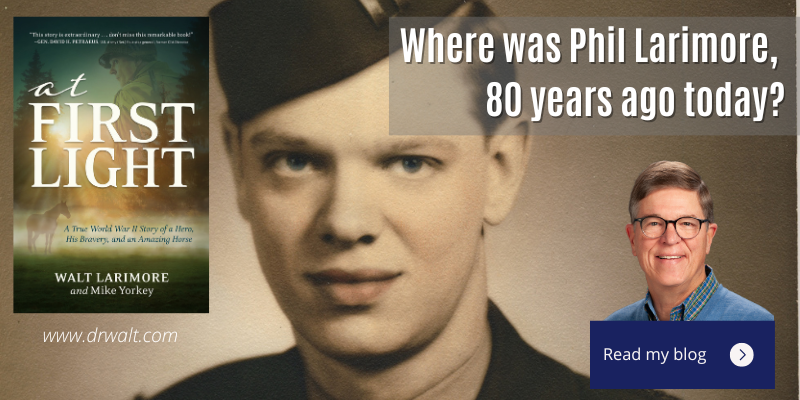
February 12, 1944 – A teenage WWII hero rides a famous Berber war horse in Morocco
February 12, 2024
February 15, 1944 – A teenage WWII hero ships out to Naples
February 15, 2024Orders were issued for 1,000 men, including Phil, to board narrow-gauge railroad cars for a three-day train ride across Morocco and Algeria to Oran, a major city and port on Algeria’s northwestern Mediterranean coast.

Below is an account from my research into Dad’s book. None of this appeared in the book:
The men were trucked to a rail yard to board the narrow gauge 40 and 8 railroad cars for the three-day ride across the Sahara Desert.
The nickname 40 and 8 derived from the tradition that each boxcar could carry forty men or eight horses (quarante hommes et huit chevaux in French). The cars were stubby, only 20.5 feet long and 8.5 feet wide.
Lieutenant Russell Cloer remembered the train as “wooden box cars, steam driven, four wheels to a car instead of eight, everything about 2/3 the size of its U.S. counterpart.”
He continued, “There was a large sliding door on each side and four small open windows high on the four corners for ventilation. Junior officers were loaded about thirty to a car with enough C-rations and water for three days stacked at one end of the car. There was not quite enough room on the floor for all of us to lie down at the same time so we had to sleep in shifts, even with only thirty to a car.”
Carl J. Hartstern described the trip: “There were thirty boys to a boxcar in addition to all the equipment, and I was sick all the way. The train had a number of flat cars with big logs on them that had no cover, which enabled some of the boys to ride up there where they could stretch out and lie down to sleep. We were thankful for that because it meant more room for us in the boxcar.”
Private ‘Bing’ Crosby W. Powell remembered, “At times the train (moved) so slowly as it climbed a hill, you could get step off, collect grapes in your helmet, and climb back on the train.”
Hartstern remembered, “This was a miserable trip, as there was standing room only.”
He wasn’t alone. One historian recorded, “Veterans’ memories of travel in the rickety, unheated cars are pretty vivid; some men even resorted to building fires inside them to keep warm on the long, slow trips.”
Cloer added, “We quickly tired of the cold C-rations and decided to try heating them with the shoe dubbing if it would burn. It was in a can like a Simonize can, flat and cylindrical, and sure enough it burned just like Sterno. Since we had each been required to carry a can, there were soon a dozen or so cans burning merrily on the wooden floor of the car, each with a C-ration can on top. All went well until the train took a sudden lurch going through a switch. The shoe dubbing, now reduced to a liquid by the heat, spread rapidly over the wooden floor burning as it went. With the draft coming up through the cracks in the floor, we instantly had a fire on our hands of considerable proportions. We were able to smother it with Army blankets and fortunately no one was injured. After that we ate our rations cold.”
“But now,” Hartstern remembered. “when the train would stop for water or any other reason, everybody would try to heat his rations by building fires beside the train tracks. When the train whistled just before pulling out, you could see fellows trying to get on with hot rations while others were running holding up their pants after a visit with nature. All in all, I saw some pretty scenery on this ride and one of the highest waterfalls I’ve ever seen.”
Cloer wrote, “We were issued live ammunition for our carbines before we left Casablanca and we soon learned to ease the boredom by shooting at the glass insulators on the telegraph lines which paralleled the railroad.
By the end of the first day, all of the ammunition was gone, as were a lot of glass insulators.”
Second Lieutenant Bud Reed added, “This country is a lot like Texas except there are a lot of very small trees. The main crop is grapes from which wine is made. The countryside is covered with vineyards. The farms are all owned by the French people but the farms are worked by Arabs.”
Bing Powell remembered, “At times the train so slowly as it climbed a hill, you could get step off, collect grapes in your helmet and climb back on the train.”
Cloer added:
There were no sanitary facilities aboard the train, so the 1500 or so troops aboard had to take advantage of any stops the train made. It would stop in the middle of the desert for no apparent reason and then start up again. There was no way of knowing how long the train would be stopped and it was not uncommon to see soldiers running and trying to pull up their pants at the same time while trying to get back aboard after a shorter than expected stop. Of course, everybody then hung out the doors and cheered them on loudly!
We lost a few who didn’t make it back to the train in time, but they were able to hitch hike a ride from the military traffic on the parallel road, and since we were traveling at only about 30 miles per hour when moving, we would find them waiting for us at the next station.[xxi]
The men reported that the “weather was pleasant during the day crossing the desert in late January. Nights in the desert were another story. It was cold! Lying on the cold wooden floor with open cracks between the boards was not conducive to sleep. What we didn’t realize was that this was solid comfort compared to what lay ahead.”
Late in the evening of the third day, the men arrived in the freight yards of Oran and were then trucked to another huge tent Repple [Replacement] Depot outside the city.
When they arrived at Lion Mountain Camp, fourteen miles east of Oran on the Mediterranean coast, the men were served a hot meal and allowed to crash in their tents.
Cloer remembered, “After three cold nights in the desert and no hot food for three days, we were overjoyed when we were told that there was a hot meal waiting for us at the Repple Depot. And there was! The cooks had taken hundreds of cans of C-rations which at that time came in three types—pork and beans, corned beef hash, and beef stew—and mixed them all together in large kettles and were heating them over open fires. That was our hot meal, and we ate it all!”
Cloer added, “Once again we were told not to leave camp. Shipment GJ432A would be leaving as soon as ship transportation could be arranged.”
Because of this, most of the men stayed in camp. However, one soldier who did go to town remembered, “I had a pass to Oran and did not like it all. The town was very dirty; it was difficult to find anything eat. The only place the GIs went was Joe’s Bar where they sold beer and wine.”
Dennis Whitehead wrote, “The buildings of Oran shone like white beacons. Close up, the soldiers were disappointed by the dinginess and extremely poor living conditions.”
But, Second Lieutenant Bud Reed wrote his fiancé, “Oran is very modern in its modern parts and as old as the Bible in its old parts. Most of the people of Oran are French.”
The men “made the best of a desert encampment in Port aux Poules on the outskirts of Oran. Sea air rusted gun barrels and fine sand from the Sahara made its way into everything,” remembered Sergeant Leon Weckstein. “In spite of round-the-clock sentries guarding the army encampment, local scavengers still managed to sneak in practically anything that wasn’t nailed down. … Added to the joys of their desert outpost was a plague of locusts.”
© Copyright WLL, INC. 2024.



